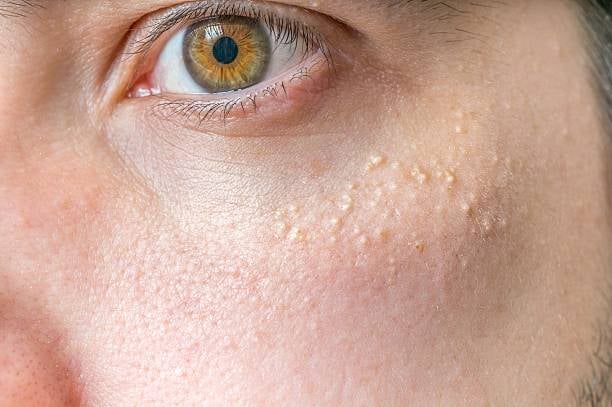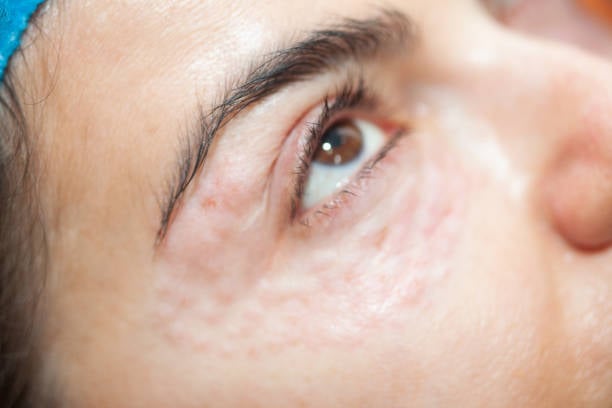Milia are small, white bumps that appear on the skin, typically around the eyes, cheeks, and nose. While these bumps are generally harmless, they can affect the overall appearance of the skin, leading individuals to seek treatment options. If you're in Riyadh and struggling with milia, there are various treatments available to help you get rid of these bumps and restore smooth, clear skin. In this blog, we will explore the best Milia Treatment in Riyadh, the causes of milia, and effective ways to remove them.

What is Milia?
Milia are tiny, hard cysts that form when dead skin cells become trapped beneath the skin's surface. These bumps are most commonly found on the face, particularly around the eyes, nose, and cheeks. While milia can appear in both adults and children, they are more prevalent in newborns. Milia are typically white or yellowish and can range in size from small dots to larger bumps.
Causes of Milia
Milia can form for a variety of reasons. The most common causes include:
Blocked Pores
When dead skin cells, oil, or sweat become trapped in the pores, they can result in the formation of milia. This blockage prevents the skin from shedding these dead cells naturally, leading to cysts.
Sun Damage
Excessive sun exposure can lead to the thickening of the outer layer of the skin, which can result in clogged pores and the formation of milia.
Skin Irritation
Harsh skincare products, frequent use of heavy creams, or exfoliating products that are too abrasive can irritate the skin and lead to milia.
Genetics
Some people may be more predisposed to developing milia due to their genetics, especially if there is a family history of the condition.
How to Prevent Milia
While it's not always possible to prevent milia, there are several things you can do to reduce your chances of developing them:
- Gentle Cleansing: Use mild cleansers that don’t strip your skin of its natural oils. Avoid harsh scrubbing, as this can irritate your skin and cause blockages.
- Exfoliation: Regular exfoliation helps to remove dead skin cells from the surface of the skin, preventing them from clogging the pores. However, it’s important to use gentle exfoliants and avoid overdoing it.
- Sunscreen: Apply sunscreen daily to protect your skin from harmful UV rays that can cause sun damage and thickening of the skin.
Best Milia Treatment in Riyadh
If you already have milia, it's important to know that there are various treatments available to get rid of them. Below, we outline some of the most effective Milia Treatment in Riyadh:
1. Manual Extraction
Manual extraction is one of the most common methods used to remove milia. This process involves a dermatologist or skincare professional using a sterile needle or lancet to create a small opening in the cyst, followed by extracting the contents of the bump.
Benefits:
- Quick and effective
- Minimal downtime
- Immediate results
Considerations:
- Must be performed by a professional to avoid scarring or infection
- Not suitable for everyone, especially individuals with sensitive skin
2. Cryotherapy
Cryotherapy involves freezing the milia using liquid nitrogen, causing the cysts to fall off after a few days. This treatment is effective for removing milia located on the face and body.
Benefits:
- Non-invasive
- Targets the milia without damaging surrounding skin
- Quick recovery time
Considerations:
- Might cause temporary redness or swelling
- Requires a professional to administer the treatment
3. Chemical Peels
Chemical peels are used to exfoliate the skin, removing dead skin cells and promoting the shedding of trapped cells beneath the surface. A chemical solution is applied to the skin, which removes the outer layers, leaving fresher, smoother skin.
Benefits:
- Helps prevent the recurrence of milia
- Improves overall skin texture
- Non-invasive with minimal discomfort
Considerations:
- May require multiple sessions for optimal results
- Potential for mild irritation or peeling post-treatment
4. Laser Treatment
Laser treatments are becoming increasingly popular for milia removal. Lasers target the milia directly, breaking down the cysts and allowing them to be naturally absorbed by the body. This method can also help improve skin texture and reduce scarring.
Benefits:
- Non-invasive and precise
- Suitable for sensitive skin
- Can improve overall skin appearance
Considerations:
- May require several sessions for effective results
- Can be more expensive than other treatments
5. Topical Treatments
Topical treatments, such as retinoid creams, can be effective in treating milia by speeding up cell turnover and preventing the formation of new milia. These treatments are often recommended by dermatologists for mild cases of milia.
Benefits:
- Easy to use at home
- Can be combined with other treatments
- Reduces the likelihood of new milia forming
Considerations:
- May take longer to see results
- Can cause dryness or irritation, especially if overused
6. Microdermabrasion
Microdermabrasion is a non-invasive treatment that exfoliates the outer layer of skin, removing dead skin cells and preventing the buildup that causes milia. It’s an ideal option for those looking for a gentle treatment with minimal downtime.
Benefits:
- Improves skin texture and tone
- Non-invasive with no recovery time
- Helps to prevent future milia formation
Considerations:
- Results may not be immediate
- Multiple sessions may be required for best results
Aftercare for Milia Removal
After undergoing Milia Treatment in Riyadh, it’s important to follow proper aftercare instructions to ensure the best results and avoid complications. Here are some key aftercare tips:
1. Avoid Sun Exposure
Protect your skin from direct sunlight after treatment, as your skin may be more sensitive. Apply sunscreen regularly to prevent further damage.
2. Gentle Skincare
Use gentle skincare products that won’t irritate or dry out your skin. Avoid harsh exfoliants or products that contain alcohol.
3. Keep the Treated Area Clean
After manual extraction or cryotherapy, keep the treated area clean and avoid touching it to prevent infection. Follow any specific instructions provided by your skincare professional.
4. Moisturize
Use a gentle moisturizer to keep your skin hydrated and promote healing after treatment. This can help reduce dryness and irritation.
When to See a Professional for Milia Treatment
While many milia will go away on their own over time, it’s important to seek professional treatment if:
- The milia are persistent and don’t go away after a few weeks
- The bumps become painful or infected
- You’re experiencing significant irritation or discomfort
Visiting a professional for Milia Treatment in Riyadh can ensure that you get the most effective and appropriate treatment for your skin type and condition.
Conclusion
Milia can be frustrating, but with the right treatment, you can achieve smoother, clearer skin. From manual extraction and cryotherapy to chemical peels and laser treatments, there are a variety of options available in Riyadh to help you tackle milia effectively. If you’re struggling with milia, consider consulting a skincare professional to determine the best course of action for your skin.
Whether you choose to remove your milia through in-office treatments or use topical solutions, the goal is to regain clear, smooth skin that you can feel confident in. The best Milia Treatment in Riyadh will depend on your skin type, the severity of your milia, and your personal preferences. Choose wisely, and take steps to prevent future breakouts by adopting a healthy skincare routine.

